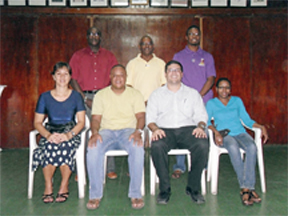– but much work lies ahead in order to advance the sport’s development
The decision by clubs to return most of the Guyana Hockey Board (GHB) executives to office is an indication of the confidence of the clubs in those officials to chart a new course for the sport.

Philip Fernandes is in his second stint as president after having served in that capacity for seven consecutive years while secretary Gregory Sills has held that portfolio for an even longer period.
Like a good captain and chief mate, they have charted a course that has kept the sport afloat despite the many challenges facing theirs and other associations locally.
Six years ago the GHB introduced an International Indoor Festival which has become one of the most sought after indoor tournaments in the Caribbean.
Teams travel from Canada, United States of America, Trinidad and Tobago and Barbados, to be part of the Diamond Mineral Water Indoor Hockey Festival normally staged at the end of November.
That festival continues to be a big drawing card for hockey teams to Guyana annually exposing some of the finest talent in the Pan American region.
Some of Canada’s leading junior players have visited these shores along with the Caribbean’s finest.
Trinidad and Tobago’s leading club Malvern, has supported the event from its inception, an indication of the positives of the event.
In addition, the GHB revived an important component of its development plans, the junior programme, which involves six schools supported by local clubs.
According to Sills, six more schools are being targeted this year.
Many of these junior players are currently exposed to the GHB’s second division competitions and only recently, the GHB was able to send a team to the Junior Pan American championships.
These positives are overshadowed by the GHB’s inability to establish a hockey centre similar to what other hockey playing nations in the Caribbean have.
Trinidad and Tobago and Barbados have both excelled on the international stage because they have secured artificial pitches and while Guyana’s players have shown potential against the best of the region, they remain handicapped due to the lack of proper playing facilities.
It is now an international requirement for hockey to be played on artificial surfaces and, because of this ruling, Guyana has been unable to host an international outdoor tournament for the past 21 years, a situation that has further undermined the sport’s development locally.
While the Cliff Anderson Sports Hall is accepted by visiting teams, the venue falls short of the required international standards for indoor hockey and has failed to attract some of the better teams from North America and Europe.
Many teams have expressed interest in attending the festival once the venue is up to scratch.
The GHB also indicated that a team will compete at the Central American and Caribbean (CAC) Games in Puerto Rico in July.
However, this will mean that local players will undergo training on the hard, outdoor grass covered ground locally but will be required to compete on artificial pitches.
This new executive must commit itself now to move the sport to a high level by dedicating itself to work towards acquiring a hockey centre.
This should be the one of the main focus of a five-year plan that the GHB needs to implement to take the sport forward.
If talks have not started, now is the time to engage the government in securing an appropriate plot of land that can be used for the construction of the centre.
Swimming and squash will soon acquire their centres with assistance from government so why not hockey?
In its negotiation with the Ministry of Culture, Youth and Sport, the GHB should also push to have one of its coaches work on a full-time basis with the ministry so that that individual would be in a better position to coordinate the junior programme.
Guyana’s hockey future is at the crossroads but now could be the opportune time to propel the sport forward should the GHB receive the assistance from its key stakeholders.




